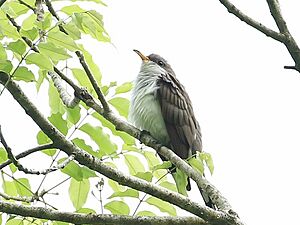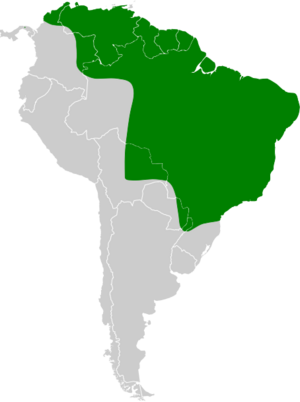Pearly-breasted cuckoo facts for kids
Quick facts for kids Pearly-breasted cuckoo |
|
|---|---|
 |
|
| Conservation status | |
| Scientific classification | |
| Genus: |
Coccyzus
|
| Species: |
euleri
|
 |
|
The pearly-breasted cuckoo (Coccyzus euleri) is a special type of bird from the cuckoo family, called Cuculidae. This bird lives in many countries in South America. You can find it in places like Argentina, Bolivia, Brazil, Ecuador, French Guiana, Guyana, Paraguay, Suriname, and Venezuela. It might even be in Colombia and Panama too!
Contents
Discovering the Pearly-breasted Cuckoo
For many years, scientists were a bit confused about the pearly-breasted cuckoo. They thought it might just be a type of yellow-billed cuckoo. This was because of a bird specimen found on Sombrero Island.
But in 1992, after a lot of study, scientists finally agreed. They decided the pearly-breasted cuckoo is its own unique species. It is now officially known as C. euleri. This means it's a distinct kind of cuckoo, not just a subspecies.
What Does the Pearly-breasted Cuckoo Look Like?
The pearly-breasted cuckoo is about 25 to 28 cm (9.8 to 11 in) long. About half of its length is its tail! Males usually weigh around 45 to 53 g (1.6 to 1.9 oz). Females are a little heavier, weighing about 54 to 61 g (1.9 to 2.2 oz).
Its Beak and Feathers
This bird has a strong beak that curves down a bit. The top part of its beak is brown or black. The bottom part is yellow or orange, with a black tip. Both male and female cuckoos look the same.
Their upper body is grayish-brown with a slight shiny bronze color. Their wings are also grayish-brown. The underside of their tail feathers has white spots on the tips.
Its Face and Chest
The cuckoo has a wide, dark gray "mask" around its eyes. There's a small ring of bare skin around its eye, which is usually black. Sometimes, this skin can be yellow or red.
Their throat and chest are a beautiful pearly grayish-white. Their belly is white, and the feathers under their tail are light pearly gray. Young cuckoos look similar to adults. But they have light edges on their wings and almost no facial mask.
Where Do Pearly-breasted Cuckoos Live?
Pearly-breasted cuckoos build their nests in Argentina, Brazil, French Guiana, Paraguay, and Venezuela. They also travel to Bolivia, Ecuador, Guyana, and Suriname when it's not breeding season. Scientists think they might also visit Colombia and Panama.
Their Favorite Homes
These cuckoos live in many different kinds of places, but most of them have trees. When they are breeding, they like forests that are always green and humid. They also like forests along rivers and forests that have grown back after being cut down.
In other seasons, they can be found in forests on high ground. They also live in woodlands with sandy soil, scrublands, and even mangrove swamps. They usually live below 900 m (3,000 ft) in height. But sometimes, they can be found as high as 1,200 m (3,900 ft).
Pearly-breasted Cuckoo Behavior
Movement and Migration
Scientists are still learning about how the pearly-breasted cuckoo travels. The cuckoos that breed in the southern parts of South America, like Argentina, fly north for the winter. They seem to go into the Amazon rainforest.
Cuckoos that breed closer to the equator might not migrate at all. But sometimes, they are seen in Guyana and Suriname when it's not breeding season. This might mean some of them do move around.
What Do They Eat?
The pearly-breasted cuckoo eats small creatures without backbones, like insects. It looks for food from the middle of the forest all the way up to the treetops. Its favorite food is caterpillars!
Usually, these cuckoos hunt alone. But sometimes, they join groups of different bird species that are all looking for food together.
Reproduction and Life Cycle
We don't know everything about how pearly-breasted cuckoos raise their young. Their breeding season changes depending on where they live. It might also depend on other things, like the weather.
It's hard to find their nests because they hide them in thick plants. Both the male and female cuckoos help build the nest. It's a loose platform made of thin, dry sticks. They usually build it in the fork of a tree branch.
A female cuckoo usually lays two to four eggs. Scientists think both parents help to keep the eggs warm. This is common for other cuckoos in the same family. The exact time it takes for the eggs to hatch is not known. But it's probably similar to other cuckoos, which is about nine to 12 days. We also don't know how long it takes for the young birds to be ready to fly.
Their Calls
The pearly-breasted cuckoo has a main song called the "Kuoup Call." It's a series of loud notes that sound a bit like a frog saying "kuoup." They usually make 5 to 15 of these sounds, but sometimes even more!
They also have a "Rattle Call." This call sounds like "tuctuctuctuctuctuc towlp, tówlp, tówlp, tówlp." It's similar to the call of the yellow-billed cuckoo.
Conservation Status
The IUCN (International Union for Conservation of Nature) has looked at the pearly-breasted cuckoo. They have decided it is a species of "Least Concern." This means it is not currently in danger of disappearing.
This bird lives in a very large area. Even though we don't know exactly how many there are, scientists believe their numbers are stable. No immediate threats have been found. However, cutting down forests and damaging their homes in South America could affect them. In some parts of northeastern Brazil, people hunt them for food.


